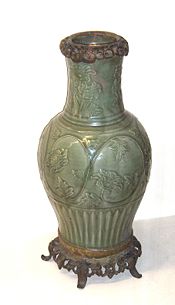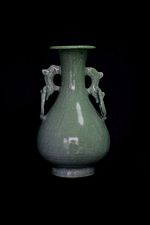
Longquan celadon
Encyclopedia

China
Chinese civilization may refer to:* China for more general discussion of the country.* Chinese culture* Greater China, the transnational community of ethnic Chinese.* History of China* Sinosphere, the area historically affected by Chinese culture...
celadon
Celadon
Celadon is a term for ceramics denoting both a type of glaze and a ware of a specific color, also called celadon. This type of ware was invented in ancient China, such as in the Zhejiang province...
produced in Longguan (龍泉) kilns which were largely located in Lishui
Lishui
Lishui is a prefecture-level city in southwestern Zhejiang province of Eastern China. It borders Quzhou, Jinhua and Taizhou to the north, Wenzhou to the southeast, and the province of Fujian to the southwest...
prefecture in southwestern Zhejiang
Zhejiang
Zhejiang is an eastern coastal province of the People's Republic of China. The word Zhejiang was the old name of the Qiantang River, which passes through Hangzhou, the provincial capital...
Province. With those in other prefectures the total of discovered kiln sites is over two hundred, making the Longquan celadon production area one of the largest historical ceramic centers in all of China.
Overview

Five Dynasty wares displayed a variety of shapes and carved finishes with the characteristic "Yuezhou" (岳州) glaze. In the Northern Song period the Dayao (大窯) kiln site alone produced wares at twenty-three separate kilns. The era of greatest ceramic production was not until the Southern Song 南宋 (1127-1279), Yuan
Yuan Dynasty
The Yuan Dynasty , or Great Yuan Empire was a ruling dynasty founded by the Mongol leader Kublai Khan, who ruled most of present-day China, all of modern Mongolia and its surrounding areas, lasting officially from 1271 to 1368. It is considered both as a division of the Mongol Empire and as an...
(元 1271-1368) and Ming
Ming Dynasty
The Ming Dynasty, also Empire of the Great Ming, was the ruling dynasty of China from 1368 to 1644, following the collapse of the Mongol-led Yuan Dynasty. The Ming, "one of the greatest eras of orderly government and social stability in human history", was the last dynasty in China ruled by ethnic...
(明 1368-1644) periods.
Longquan celadons thus were an important part of China's export economy for over five-hundred years. From the twentieth century native and foreign enthusiasts and scholars have flocked to the kiln sites. Among modern Chinese scholars themselves, the main kiln sites were first systematically investigated by Chen Wanli in 1927 and 1934. According to local gazetteer
Gazetteer
A gazetteer is a geographical dictionary or directory, an important reference for information about places and place names , used in conjunction with a map or a full atlas. It typically contains information concerning the geographical makeup of a country, region, or continent as well as the social...
entries two celebrated ceramicists and brothers, Zhang Shengyi (章生一) and Zhang Shenger (章生二), worked at the main Dayao kilns The Longquan Prefecture Gazetteer (龍泉省志) noted that their celadon reached jade
Jade
Jade is an ornamental stone.The term jade is applied to two different metamorphic rocks that are made up of different silicate minerals:...
-like perfection. Thus began the Ming period tradition of dividing the best Longquan wares into Elder Brother and Younger Brother categories. Elder Brother ware was thought to be the Geyao (哥窯) crackle glaze ware treasured by collectors throughout history. Recently this confusion has begun to resolve itself with excavations of the Hangzhou
Hangzhou
Hangzhou , formerly transliterated as Hangchow, is the capital and largest city of Zhejiang Province in Eastern China. Governed as a sub-provincial city, and as of 2010, its entire administrative division or prefecture had a registered population of 8.7 million people...
(杭州) official ware kilns and others.
Southern Song celadons display the greatest variety of shape and glaze color. Japanese
Japan
Japan is an island nation in East Asia. Located in the Pacific Ocean, it lies to the east of the Sea of Japan, China, North Korea, South Korea and Russia, stretching from the Sea of Okhotsk in the north to the East China Sea and Taiwan in the south...
tea masters and collectors have treasured examples with a decidedly bluish glaze which they have termed "kinutaseiji" (砧青磁). Chinese collectors have perhaps enjoyed a greater variety of Longquan ware and devised a special vocabulary to describe them such as meizi ching or “plum green” celadon. After the Southern Song period Lonquan celadon experienced an expansion of production with a lessening of quality. However even the stoutly potted celadons of the Ming period have had their imitators at Jingdezhen (景徳鎮) and in Japan
Japan
Japan is an island nation in East Asia. Located in the Pacific Ocean, it lies to the east of the Sea of Japan, China, North Korea, South Korea and Russia, stretching from the Sea of Okhotsk in the north to the East China Sea and Taiwan in the south...
. Scholarly appreciation of Longquan celadon experienced great progress with the discovery of a sunken trade vessel in Sinan County
Sinan County
Sinan County is a county in the province of Jeollanam-do, South Korea. The county consists of 111 inhabited islands and 719 uninhabited islands. The number of islands in this county accounts for 25% of all islands in South Korea...
off the Korea
Korea
Korea ) is an East Asian geographic region that is currently divided into two separate sovereign states — North Korea and South Korea. Located on the Korean Peninsula, Korea is bordered by the People's Republic of China to the northwest, Russia to the northeast, and is separated from Japan to the...
n coast in 1976. It was discovered that finely finished Southern Song style celadon was manufactured well into the Mongol or Yuan period.
See also
- CeladonCeladonCeladon is a term for ceramics denoting both a type of glaze and a ware of a specific color, also called celadon. This type of ware was invented in ancient China, such as in the Zhejiang province...
- Chinese porcelainChinese porcelainChinese ceramic ware shows a continuous development since the pre-dynastic periods, and is one of the most significant forms of Chinese art. China is richly endowed with the raw materials needed for making ceramics. The first types of ceramics were made during the Palaeolithic era...
- Korean pottery and porcelain
- Japanese potteryJapanese potteryJapanese pottery and porcelain , one of the country's oldest art forms, dates back to the Neolithic period...

